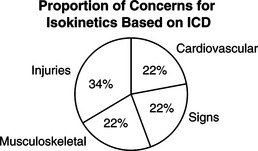Chapter 16 Strength, Power, and Endurance Training
OVERVIEW.
Active range of motion (AROM, also active assisted range of motion [AAROM]) is movement generated by active muscle contraction and produced within the unrestricted portion of a joint. In active-assisted range of motion, manual or mechanical assistance is provided by an outside force to assist the prime mover through the available joint range.1,2 AROM concerns generally relate to acute cardiac or vascular conditions, stress to unstable or still fragile musculoskeletal or skin tissue (e.g., postop, injuries), or activities that further compromise a structure (e.g., spinal stenosis) (also see ROM assessment).
CONTRAINDICATIONS AND PRECAUTIONS
I00-I99 DISEASES OF THE CIRCULATORY SYSTEM
L00-L99 DISEASES OF THE SKIN AND SUBCUTANEOUS TISSUE
M00-M99 DISEASES OF THE MUSCULOSKELETAL SYSTEM AND CONNECTIVE TISSUE
O00-O99 PREGNANCY, CHILDBIRTH, AND PUERPERIUM
R00-R99 SYMPTOMS, SIGNS INVOLVING THE SYSTEM
S00-T98 INJURY, POISONING, AND CERTAIN OTHER CONSEQUENCES OF EXTERNAL CAUSES
1 Kisner C, Colby LA. Therapeutic exercise: foundations and techniques, ed 3. Philadelphia: FA Davis, 1996.
2 Bottomley JM. Quick reference dictionary for physical therapy. Thorofare (NJ): Slack, 2000.
3 Tan JC. Practical manual of physical medicine and rehabilitation: diagnostics, therapeutics, and basic problems. St Louis: Mosby, 1998.
4 Pierson FM, Fairchild SL. Principles and techniques of patient care, ed 3. Philadelphia: Saunders, 2002.
5 Staley M, Serghiou M. Casting guidelines, tips and techniques: proceedings from the 1977 American Burn Association PT/OT Casting Workshop. J Burn Care Rehab. 1998;19(3):254-260.
6 Brander VA, Stulberg SD. Rehabilitation after lower limb joint reconstruction. Delisa JA, editor. Physical medicine and rehabilitation: Principles and practices, vol 1. Philadelphia: Lippincott Williams & Wilkins, 2005.
7 Maihafer GC. Rehabilitation of total hip replacements and fracture management considerations. In: Echternach JL, editor. Physical therapy of the hip. New York: Churchill Livingstone, 1990.
8 Hall C. Therapeutic exercise for the lumbopelvic region. In: Hall CM, Brody LT, editors. Therapeutic exercise: moving toward function. Philadelphia: Lippincott Williams & Wilkins, 2005.
9 Brody LT. Impaired joint mobility and range of motion. In: Hall CM, Brody LT, editors. Therapeutic exercise: moving toward function. Philadelphia: Lippincott Williams & Wilkins, 2005.
16.2 Closed Chain Exercise
Closed chain (CC) exercises involve activities where an individual’s proximal body part moves over his or her fixed (i.e., stabilized) distal segment. An example is performing an upper extremity push-up.1 There is some concern for stressing joints, particularly at the knee, while performing squats (a closed chain activity) at certain angles following ACL injuries or repairs.
CONTRAINDICATIONS AND PRECAUTIONS
M00-M99 DISEASES OF THE MUSCULOSKELETAL SYSTEM AND CONNECTIVE TISSUE
R00-R99 SYMPTOMS, SIGNS, AND ABNORMAL CLINICAL AND LABORATORY FINDINGS (NOT ELSEWHERE CLASSIFIED)
S00-T98 INJURY, POISONING, AND CERTAIN OTHER CONSEQUENCES OF EXTERNAL CAUSES
1 Kisner C, Colby LA. Therapeutic exercise: foundations and techniques, ed 3. Philadelphia: FA Davis, 1996.
2 Lefever SL. Closed kinetic chain training. In: Hall CM, Brody LT, editors. Therapeutic exercise: moving toward function. Philadelphia: Lippincott Williams & Wilkins, 2005.
3 Brownstein B, Brunner S. Patella fractures associated with accelerated ACL rehabilitation in patients with autogenous patella tendon reconstruction. J Orthopaed Sports Phys Ther. 1997;26(3):168-172.
16.3 Eccentric Exercise
Eccentric exercise is a form of dynamic resistive exercise that involves tension development while the muscle is lengthening.1 Familiar functions involving eccentric activity of the lower limbs include sitting down or descending stairs. Sources identify delayed muscle soreness from microtrauma as a concern following eccentric work.1,2 In more severe cases, rhabdomyolysis may occur.3
1 Kisner C, Colby LA. Therapeutic exercise: foundations and techniques, ed 3. Philadelphia: FA Davis, 1996.
2 Hall CM, Brody LT. Impairment in muscle performance. In: Hall CM, Brody LT, editors. Therapeutic exercise: moving toward function. Philadelphia: Lippincott Williams & Wilkins, 2005.
3 Sayers SP, Clarkson PM, Rouzier PA, Kamen G. Adverse events associated with eccentric exercise protocols: six case studies. Med Sci Sports Exerc. 1999;31(12):1697-1702.
16.4 Isometric Exercise
Isometric exercise is a static form of exercise whereby tension develops in the muscle but there is essentially no joint movement. The length of the muscle remains unchanged during the contraction. Three sources identify four cardiovascular concerns for isometric exercise that primarily center around the pressor (increased blood pressure) response (also see Resistive exercise).
I00-I99 DISEASES OF THE CIRCULATORY SYSTEM
1 Kisner C, Colby LA. Therapeutic exercise: foundations and techniques, ed 3. Philadelphia: FA Davis, 1996.
2 Tan JC. Practical manual of physical medicine and rehabilitation: diagnostics, therapeutics, and basic problems. St Louis: Mosby, 1998.
3 Hall CM, Brody LT. Impairment in muscle performance. In: Hall CM, Brody LT, editors. Therapeutic exercise: moving toward function. Philadelphia: Lippincott Williams & Wilkins, 2005.
16.5 Isokinetic Exercise
Isokinetic exercise is a form of resistive exercise in which a rate-limiting device controls the movement speed of the joint.1 The device is used both for strength testing and exercise. Two sources identified nine concerns for isokinetic exercise, with the largest proportion related to unhealed injuries. Joint and bone instability was a shared concern (see Isokinetic testing, Exercise equipment for complications; also see Resistive exercise).
< div class='tao-gold-member'>
Stay updated, free articles. Join our Telegram channel

Full access? Get Clinical Tree



























